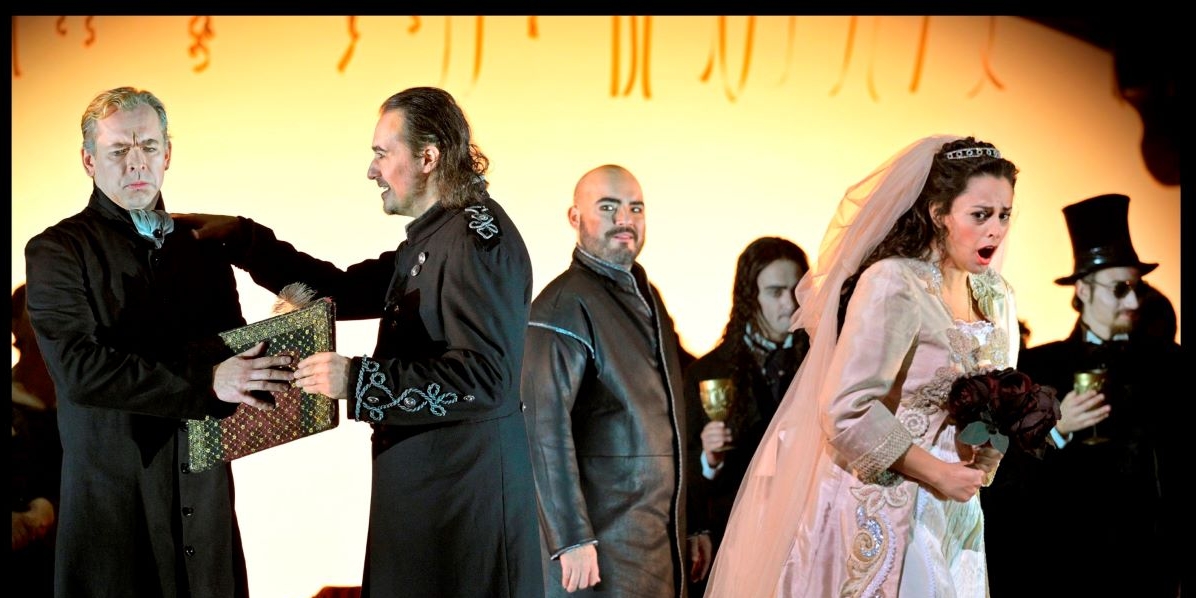Over the years Hollywood has accustomed us to movies that speak English, no matter where the story takes place – be it the Roman empire or Nazi Germany. In the opera world, Italian is the reigning “international” language. Gaetano Donizetti’s most popular opera Lucia di Lammermoor presumably takes place in a castle in Scotland, but all the characters have Italian names, or rather Italian versions of the names of the characters in Walter Scott’s 1819 novel The Bride of Lammermoor.
Like many opera heroines, Lucia (Lucy in the novel) is a tragic victim of men’s follies, but she takes the tragedy one step further and loses her mind, killing the bridegroom forced upon her by her brother, before departing from this world. The nearly half hour “mad scene”, in which she wanders in a bloodied dress among the wedding guests, made this demanding role particularly attractive for coloratura sopranos such as Maria Callas and Joan Sutherland.
Israeli soprano Hila Fahima, who has been performing mostly in European opera houses, returned to Tel Aviv to sing Lucia, and gave a delicate and very moving interpretation of the heroine, caught between her brother and her lover, who hate each other for no good reason. It wasn’t the performance of a great diva, but that of a fragile teenage girl who was crushed by the pains of first love and betrayal. Fahima’s lovely voice matched that of the flute in the cadenza, which was conceive as a duet between the two, and her graceful movement on stage contributed to the beauty and delicacy of the scene.
The other star of the show was the layered lighting design. This production was first presented on the Tel Aviv Opera stage in 2012, and again in 2017. It was originally directed by Emilio Sagi and lit by Eduardo Bravo. However, the director of this year’s revival, Omer ben Seadia, and lighting designer Nadav Barnea added quite a lot to the original concept. Lucia is now accompanied by four dancers who serve as her maids and later metamorphose into spirits when she starts hallucinating. In the first act, the four are adorned in black dresses and the striking golden backlight gives them the appearance of a shadow play. If only their choreography had been a bit more inspired, the scene could have been even more gorgeous. In the third act they switch to white flowing dresses, serving as bridesmaids before the lighting turns them into spirits.
While this is undoubtedly Lucia’s opera, the male roles were also strong. Israeli Baritone Oded Reich was commanding as the vindictive brother Enrico, who thoughtlessly ruins his sister’s life. When told she is having an affair with his nemesis Edgardo – the reasons have something to do with a blood feud – he actually sings he would rather have her dead than let her shame him. His remorse comes much too late. The lover Edgardo was portrayed by the Italian tenor Oreste Cosimo, who gave a virile yet tender performance. The American tenor Anthony Webb was not as strong in the role of the unwanted groom Arturo. In fact, his voice sounded weak and was almost drowned by the orchestra. However, the fact that like Oded Reich he sports a bold head and a beard, created the impression that the narcissistic Enrico chose his lookalike as a husband for his sister.
Conducted by Carlo Montanaro the orchestra sounded fluent and especially beautiful were the solo bits played by the harp, the flute and the cello. The celebrated sextet Chi mi frena in tal momento shortly before the end of act II was so beautifully sung, it received a very long applause, leading the singers and the chorus to repeat it. This was the first time I experienced a mid-performance encore at the Israeli opera, and it was well deserved.

